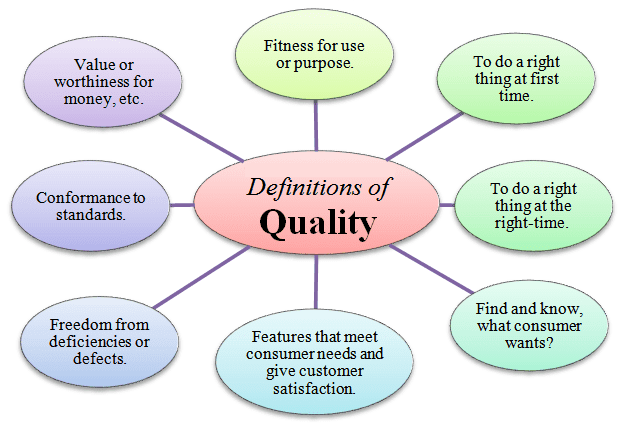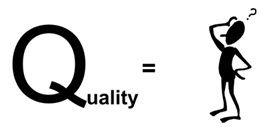
“High quality is free, however solely to those that are keen to pay closely for it.”
– T. DeMarco and T. Lister
Partially 1 of this collection, What’s QA?, we talked about High quality Assurance (QA) and the way it means various things to totally different folks. Different elements for these totally different meanings are the various definitions surrounding the phrase “high quality” by itself. Everyone knows high quality is necessary, and all of us have an thought of what it means. But it surely’s not that simple to outline by way of a challenge. For some, it means reliability and effectivity. To others, it means health of function, or usability. For example, listed below are simply a few of the definitions you’ll find on-line.

However these are principally generalizations. The reality is each single one in every of us can have a distinct thought of what high quality actually is, and nonetheless be proper, relying on the context. Nevertheless, I believe most individuals will agree on these two issues:
- High quality is subjective. It’s decided by whoever is utilizing the product on the time.
- High quality is relative. It adjustments over time.

For example, for these of you who bear in mind again within the early days of the web, we had been (considerably) comfortable to attend a number of minutes for the connection by a dial-up modem, or for a web page to load. We might go get a cup of espresso, sit again down, and start to surf the web. No downside.
Immediately, the web connection is at all times current, and the web page or the app had higher load inside a few seconds or we get very aggravated and will by no means use that website or that app once more.
Our collective expectations of high quality and our tolerance of points have shifted over time.
It’s no marvel that high quality is so tough to outline. All of us outline it in a different way and we frequently change that definition over time.
In his annual letter to shareholders in 2017, Amazon founder, Jeff Bezos, talked about continuous buyer obsession as the important thing to Amazon’s development. He said that prospects are at all times, “divinely discontent.” Their expectations by no means stay the identical; their wants are endlessly rising, and their perspective is ever altering. They are going to at all times need one thing higher than what they’ve in the present day.
That’s the essence of high quality. It’s arduous to outline as a result of nothing about it’s fixed. That can also be the problem and the necessity for QA. It’s true that if we will sustain with the growing buyer expectations, we’ll receive a better high quality in our initiatives (software program, companies, or integrations). However this will additionally create a battle inside the challenge as a result of the rising expectations might end in extending the challenge’s scope. There’s a tremendous line right here. We wish to repeatedly enhance the product, however not on the expense of the challenge.
QA will help on this effort by getting concerned early within the necessities discovery exercise. The challenge is putting in some software program or service as a way to clear up an issue. The necessities exercise will uncover necessities that reveal that downside. With out good necessities, we won’t know if we’re fixing the actual downside or another person’s thought of the issue. Time spent uncovering the essence of the actual downside is vital.
“If I got one hour to save lots of the planet, I’d spend 59 minutes defining the issue…” – Albert Einstein
Whereas which will sound excessive, it does spotlight the significance of defining the issue, or issues, to be solved. We’ll discuss way more in regards to the necessities exercise in a future put up.

So what’s High quality?
With a purpose to outline high quality because it pertains to initiatives at UConn, we’ll take a look at high quality by way of software program initiatives and integrations. Among the greatest software program testers within the business have been defining and redefining high quality over the past a number of years. One of many first was Gerald M. Weinberg, an acclaimed writer, author, and marketing consultant. Right here is his unique definition of high quality:
“High quality is worth to some individual”.
By “worth,” he means, what are folks keen to pay (or do) to have their necessities met? It’s easy and to the purpose. It’s additionally broad and begs to be additional outlined, which it was; by one other very well-known tester and marketing consultant, James Bach, who refined it to:
“High quality is worth to some one who issues”.
Then, after recognizing how high quality adjustments over time, the definition was additional refined by each James and one other tester, Michael Bolton, (not the singer) to:
“High quality is worth to some individual, at a while, who issues.”
So there you may have it. A present and helpful definition of high quality. This simply highlights high quality’s subjective nature and the necessity to continually re-evaluate it. Here’s a latest instance that reveals whose thought of high quality issues when deciding on what must be corrected.
A High quality Instance from UConn
Whereas testing early on within the Concur challenge, I discovered what I believed was a bug in Concur’s software program. I had chosen a sure airport from the drop-down listing within the Request Module to finish a Journey Request. After I went to finish the expense report, within the Expense Module, I couldn’t discover that very same airport within the drop-down. The consumer interface additionally had a barely totally different appear and feel. As I regarded additional, I noticed that these had been two utterly totally different lists. Why wouldn’t they use the identical drop-down listing in each modules to keep away from confusion and preserve consistency?
Pondering that this was a top quality problem, I reported it to Concur pondering different firms and universities would have the identical concern. To my shock, they weren’t involved with the difficulty. That they had two separate software program groups, engaged on these two modules. Not shocking, however what was shocking was that these two groups didn’t even discuss to one another. That defined the totally different appear and feel and the totally different drop-down lists. Weren’t they involved in regards to the high quality of their product?
It turned out that the explanation they weren’t involved was that we had been not utilizing their product the best way most of their customers use it. Most of Concur’s prospects use solely the Request Module or the Expense Module, however not each. We’re a minority in the best way we’re utilizing it. I don’t know the precise numbers, however for this instance, let’s say 10% use each modules. Does it make sense for Concur to redirect their improvement effort so solely 10% (or fewer) of their prospects profit from it? And the opposite 90% won’t? In fact, we wish to assume so if we’re the ten%. However in actuality, not if there are actual issues nonetheless affecting the opposite 90%.
Clearly, in defining high quality for the Concur product, any points which can be reported by the 90% are from the “one who issues.” I wish to assume that in time, the Concur groups will come collectively to create the identical appear and feel for all of their merchandise.
In any case, this is a vital consideration for us when including any new SaaS product to UConn’s processes. In these conditions, we’re on the mercy of another person’s product high quality selections, and we might not at all times be the “one who issues” within the choice making course of.
Within the subsequent part, we’ll take a more in-depth take a look at testing and the way it has developed over time.
Thanks for stopping by!
Mick
Associated articles:
Introducing QA Half 1: What’s QA?
Introducing QA Half 3: What’s Testing?
Introducing QA Half 4: How can QA Assist You?

